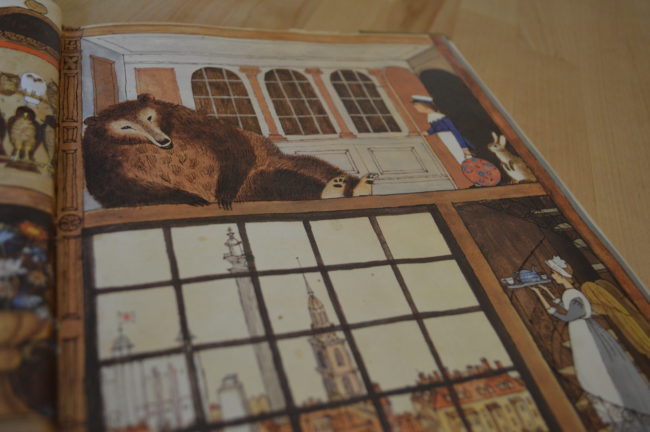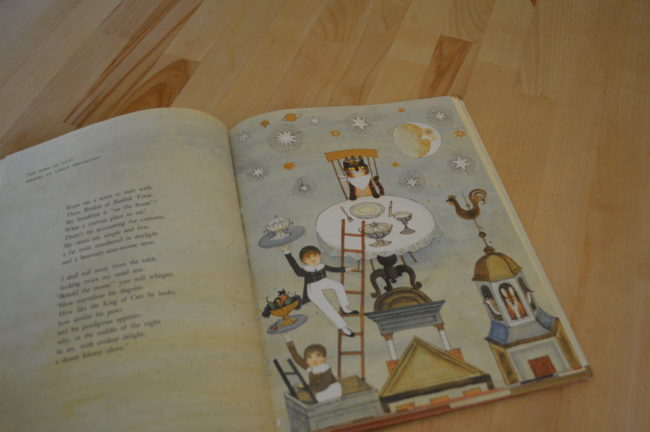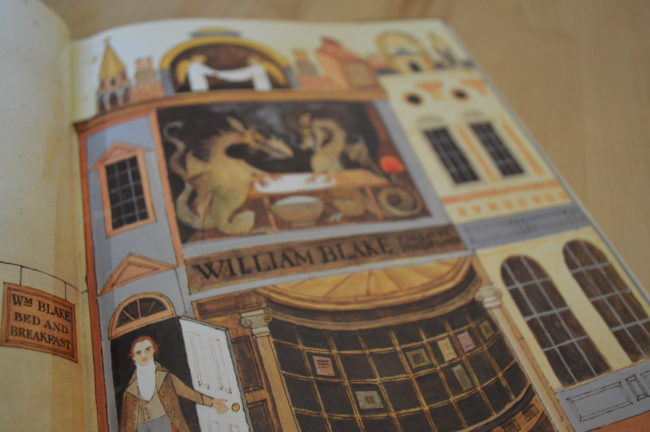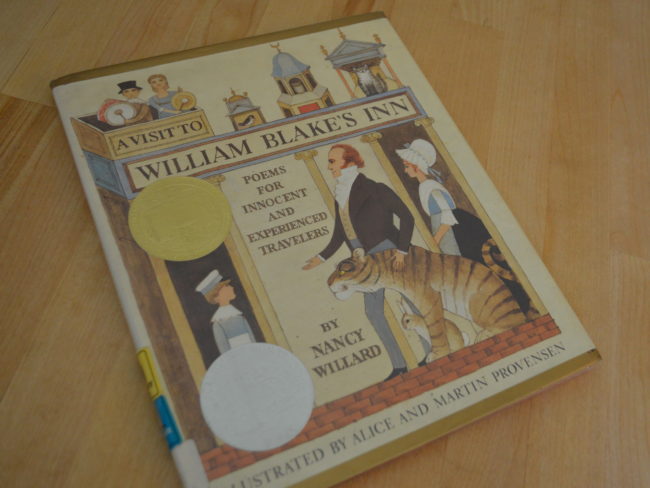
Writing in the style of William Blake’s short lyrical poems, Nancy Willard’s short, beautifully illustrated book A Visit to William Blake’s Inn: Poems for Innocent and Experienced Travelers won the 1982 Newbery. It was the first book of poetry to win the Newbery, and Alice and Martin Provensen’s illustrations won the book a Caldecott honor the same year. Willard’s poems sound a great deal like Blake’s both in terms of rhythm and rhyme as well as with some shared images–sunflowers, tigers, angels, stars, suns, children, bells, sleep, dreams, and moonlight. In Willard’s book, a little boy travels to William Blake’s Inn, where dragons bake the bread, angels fluff the pillows, a rabbit shows him to his room where there’s a bear for a bed, and a tiger, sunflowers, and the man with the marmalade hat for other guests.

There is not really a plot per se; it’s more like a series of little songs (or nursery rhymes) that are related and tied together through illustrations of the rooms of the Inn. I read the whole thing through at least four times, and found parts of it fun and parts kind of weird. (But I also freely admit that I know very little about poetry, and perhaps that was what the Newbery selection committee was trying to do something about!)

What I liked. I liked that this was the first Newbery book I could read with my 3 year old Jackson. It felt much more like the sort of picture-poetry book that we pick out at the library for when he is in a focused mood (i.e. baby sister Lily is sleeping). Actually reading it aloud to Jackson helped me grasp the poetry better. So that’s how I’d recommend you read it. (Also, I think I’ve read more poetry in the past few years aloud to Jackson than I had read for many, many years.)

What was interesting. William Blake, it turns out, was a very interesting fellow. And while he is a character in the book (it’s his Inn), it is his poetry that really comes through in the book more than the man himself. For example, his famous 1794 poem “The Tyger” is directly quoted in the opening inscription of the book, and a tiger pops up in this book a number of times. The subtitle of the book “for innocent and experienced travelers” is a reference to Blake’s poetry collections Songs of Innocence and Songs of Experience. William Blake, the actual 18th century man, was a poet, painter, and print maker. The image of his I was most familiar with was his print: Ancient of Days.

I’m sure that if you knew more about William Blake and his work that reading and rereading A Visit To William Blake’s Inn would produce fun references and homages to his work that I’ve completely missed.

What were some limitations and similarities to other Newberies. I don’t want to seem anti-poetry, but I have to say I felt like this was an odd choice for the Newbery. Most of the Newbery books are narrative prose books at least 180 pages long, and this little 48-page book of poetry seemed so out of place with the others. Since 1982, however, five other poetry books have won : Joyful Noise (1989), Out of the Dust (1998), Good Masters! Sweet Ladies! (2008), Crossover (2015). Then, while not a book of poetry Last Stop of Market Street (2016) was a good deal shorter at 32 pages (also a winner of a Caldecott honor, like A Visit to William Blake’s Inn).
There seems to be a lack of awards for children’s poetry. When this book was published the NCTE Award for Excellence in Poetry for Children had been around for about five years (it honored a lifetime contribution to children’s poetry), but it wasn’t until 1993 that IRA Lee Bennett Hopkins Poetry Award was created, 1998 that The Claudia Lewis Award was established, and 2003 that the CLPE Poetry Award for a book of poetry for children began.

What it teaches me as a writer. One way this book inspired my writing is that I have a magical inn in my book that has many rooms. (It’s not as trippy as this inn, but still.) On the back flap of the edition of this book I got from the library, it says that while author Nancy Willard was writing poems for this book, she “built a six-foot model of the inn, decorating it with moon, suns, stars, and prints of Blake’s paintings. The model with its residents–the characters that appear in this volume–stands in her living room.” So while there were separate illustrators (Alice and Martin Provensen) for the book, I think perhaps the way that the poems lent themselves to such beautiful illustrations might have come from the author’s careful creation of the world of the inn in both model and text form. It makes me want to spend some time drawing out all the rooms of my tree house inn!

Have you read A Visit to William Blake’s Inn? What are your favorite books of poetry for children?
Note This post contains Amazon affiliate links, which means if you were to buy a book, I’d get a tiny commission at no cost to you. Thanks for supporting Stories & Thyme!*
